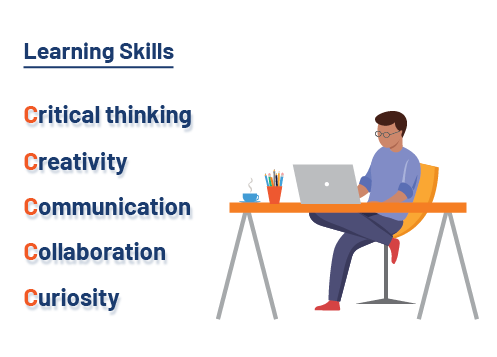In Part 1 of this article series, we explored five key life skills that equip eLearning professionals to thrive in a virtual work environment. These skills are identified in the acronym ‘FLIPS’, which stands for flexibility, leadership, initiative, productivity and social skills.
In this article, we’ll build on these ideas by unpacking five essential learning skills – i.e. the cognitive competencies that are required for learning, developing and adapting both personally and professionally. By nurturing these skills, eLearning professionals within virtual teams can be better equipped to thrive in the dynamic context of Industry 4.0.
Learning skills: The five Cs
In an eLearning environment, we can identify five essential learning skills, also known as the ‘five Cs’.

(Source: EDGE Education (Pty) Ltd, 2020; adapted from National Education Association, 2019)
Critical thinking
A strong critical thinker is also a strong decision-maker and problem-solver (GCFGlobal, n.d.). In an eLearning context, critical thinking is an especially valuable skill, as it allows us to look beyond generic options and to identify truly innovative solutions. This skill is also essential in a virtual workspace. Here, employees typically work in a more isolated setting, and may therefore be required to engage in independent problem-solving (Farrer, 2020). As such, critical thinking skills enable us to become more resourceful and creative in addressing potential roadblocks.
Additionally, eLearning professionals leverage their critical thinking abilities to create robust and engaging eLearning solutions for their clients – making critical thinking a prerequisite for sound learning design. In other words, before they can create meaningful learning experiences and stimulate critical thinking in others, eLearning professionals must be able to engage in critical thinking themselves.
Creativity
Much like critical thinking, creativity involves pushing the boundaries and looking beyond what is given. In the eLearning context, the need for creativity is a constant. With the increasing shift toward online learning, eLearning professionals must be able to design creative learning solutions that not only facilitate learning, but also keep students engaged and wanting more (Glass, 2016). However, there is often a fine balance between engagement and entertainment – meaning that creativity must serve the learning process, instead of hindering it.
This is even more relevant in the wake of Covid-19 and the subsequent trend toward ‘emergency remote teaching and learning’ (ERT/L), where online learning solutions have become commonplace for many. As such, eLearning professionals need to keep finding new ways to drive engagement by identifying learning solutions that are both creative and pedagogically sound.
Communication
Communication is considered one of the most vital tools for any team. In an eLearning context, communication takes place between various stakeholders – both internal (within teams and departments) and external (with subject matter experts, or SMEs, as well as clients or the learners themselves). However, as most of us have experienced over the last two years, remote communication (e.g. via Zoom or Slack) isn’t as straightforward as communicating face to face. To ensure that communication is effective and dynamic in a virtual workspace, it’s helpful to keep the ‘five Cs of communication’ in mind (Keates, 2018):
- Clear: Pinpoint the key message and takeaway before sharing it with your listener.
- Concise: Keep your communication simple, direct and to the point.
- Compelling: Indicate the necessary actions that you’d like your listener to take.
- Curious: Be a good listener and ensure that you acknowledge the needs of others.
- Compassionate: Remain empathetic and sensitive.
Collaboration
With effective communication, opportunities for collaboration increase. In a virtual work environment where team members may be required to work with people they’ve never met face to face, collaboration often takes place online (e.g. via email, conference calls or instant messaging). Here, it’s especially important for eLearning professionals to hone their collaboration skills to fulfil their roles effectively.
Collaboration is also vital in terms of designing and producing quality eLearning materials. For example, eLearning professionals need to be adept at cooperating with clients to interpret and analyse their needs effectively, and to develop solutions that meet these needs. They may also need to collaborate with SMEs to design quality learning materials in a wide variety of fields.
Curiosity
Typically, there have only been four Cs included in the list of learning skills. However, in recent years, a fifth C has been recognised, both within business and educational settings: curiosity. Although curiosity may not strictly qualify as a ‘skill’, it is a vital disposition that fosters innovation and creativity. At its core, curiosity is about remaining inquisitive and open to possibilities. This disposition also comes with several benefits that are helpful in a virtual team (Gino, 2018):
- Fewer decision-making errors: Teams are less likely to fall prey to confirmation bias or stereotyping when they retain a curious mindset and are open to alternative suggestions.
- Greater potential for innovation: Curiosity allows us to approach challenges more creatively, and prompts us to ask questions such as ‘Why?’, ‘What if …?’ and ‘How might we …?’
- Reduced group conflict: Curiosity allows us to empathise with others, by encouraging us to view things from perspectives other than our own. This leads to better cohesion and collaboration within a team.
- Improved communication and performance: Curiosity can also be displayed in how and when we communicate with others. It encourages us to seek the input and perspectives of others, thereby allowing us to learn from others and to improve our own knowledge and skills.
Of course, curiosity is also a hallmark of good learning design. When learners are curious, they are more engaged and invested, which leads to a deeper and more meaningful learning experience.
Final thoughts
In this two-part article series, we’ve outlined some of the most sought-after soft skills in the recruitment of eLearning candidates (Pappas, 2014; and Taylor, 2016). These skills are invaluable for any professional working in the eLearning context – and even more so within a virtual team.
By cultivating flexibility, leadership, initiative, productivity and social skills (life skills), members of virtual eLearning teams can help to build a positive and innovative culture among their peers, and they can become valuable assets within their organisation. Similarly, by fostering critical thinking, creativity, communication, collaboration and curiosity (learning skills), eLearning professionals will be better equipped to learn, develop and adapt, and to deliver engaging and meaningful learning experiences to others.
Reference list
Education Week [website] ‘The Importance of Curiosity and Questions in 21st-Century Learning’. <https://blogs.edweek.org/edweek/global_learning/2017/05/the_5th_c_curiosity_questions_and_the_4_cs.html> accessed 8 October 2020.
Farrer, L. (2020), ‘Academic Research Proves 8 Skills Critical To Work-From-Home Success’. Forbes [website] <https://www.forbes.com/sites/laurelfarrer/2020/03/19/academic-research-proves-8-skills-critical-to-work-from-home-success/?sh=24f4aae624e3> accessed 3 March 2021.
GCFGlobal [website] ‘What is critical thinking?’ <https://edu.gcfglobal.org/en/problem-solving-and-decision-making/what-is-critical-thinking/1/> accessed 3 March 2021.
Gino, F. (2018), ‘The Business Case for Curiosity’. Harvard Business Review [website] <https://hbr.org/2018/09/the-business-case-for-curiosity> accessed 20 October 2021.
Glass, G. (2016), ‘Must-have skills for successful e-learning professionals’. Matrix Blog [website] <https://blog.matrixlms.com/must-skills-for-successful-e-learning-professionals> accessed 8 October 2020.
Keates, C. (2018), ‘The Five C’s Of Effective Communication’. Forbes [website] <https://www.forbes.com/sites/forbescoachescouncil/2018/09/10/the-five-cs-of-effective-communication/?sh=4f6f3dc520c8> accessed 16 May 2021.
National Education Association (2019), Preparing 21st Century Students for a Global Society: An Educator’s Guide to the “Four Cs”. Washington, DC: National Education Association.
Pappas, C. (2014), ‘Top 10 eLearning Skills That eLearning Professionals Should Have’. eLearning Industry [website] <https://elearningindustry.com/top-10-elearning-skills-elearning-professionals> accessed 3 March 2021.
Taylor, T. (2016), ‘Top 7 Skills That Today’s eLearning Jobs Demand’. eLearning Industry [website] <https://elearningindustry.com/elearning-jobs-demand-top-skills> accessed 8 October 2020.



